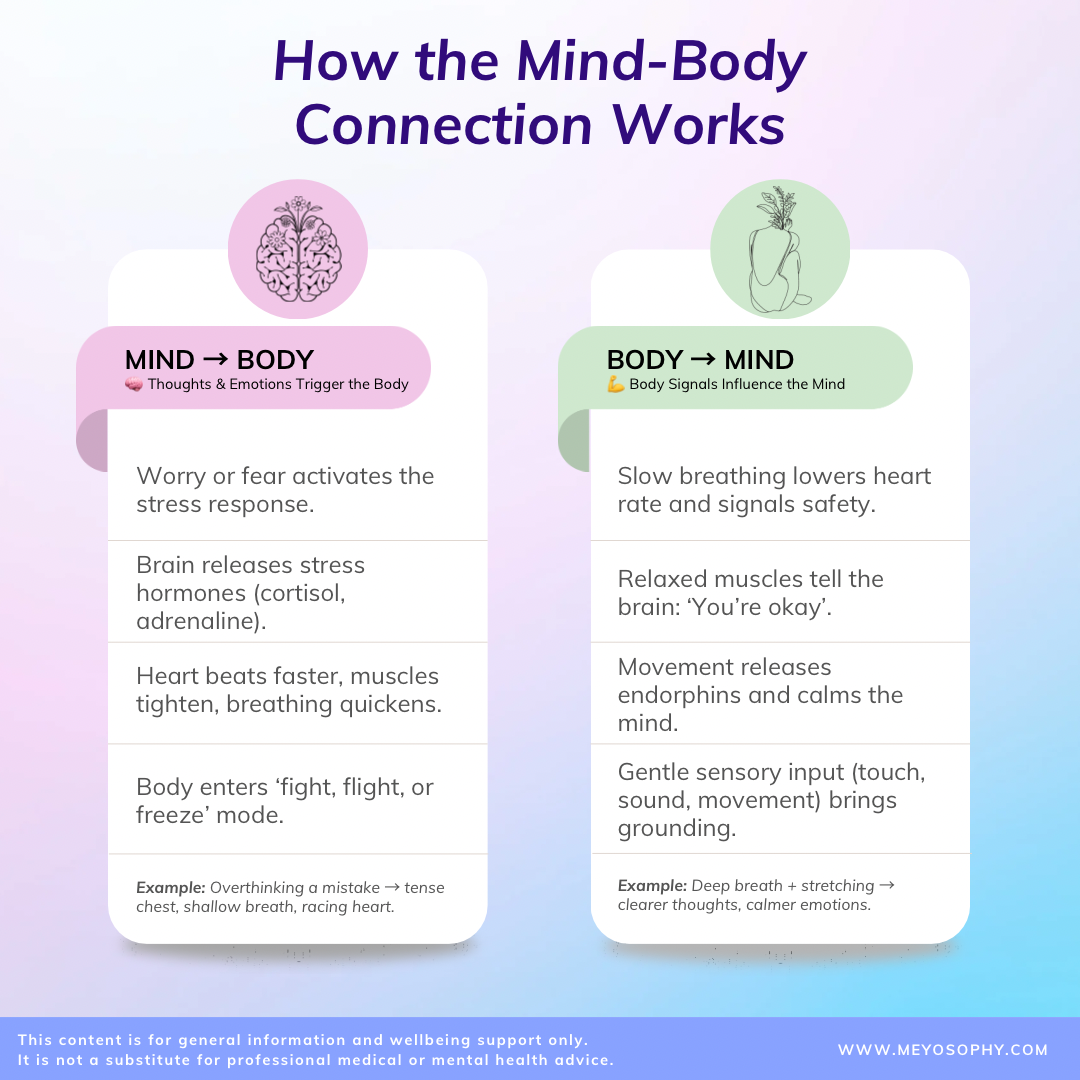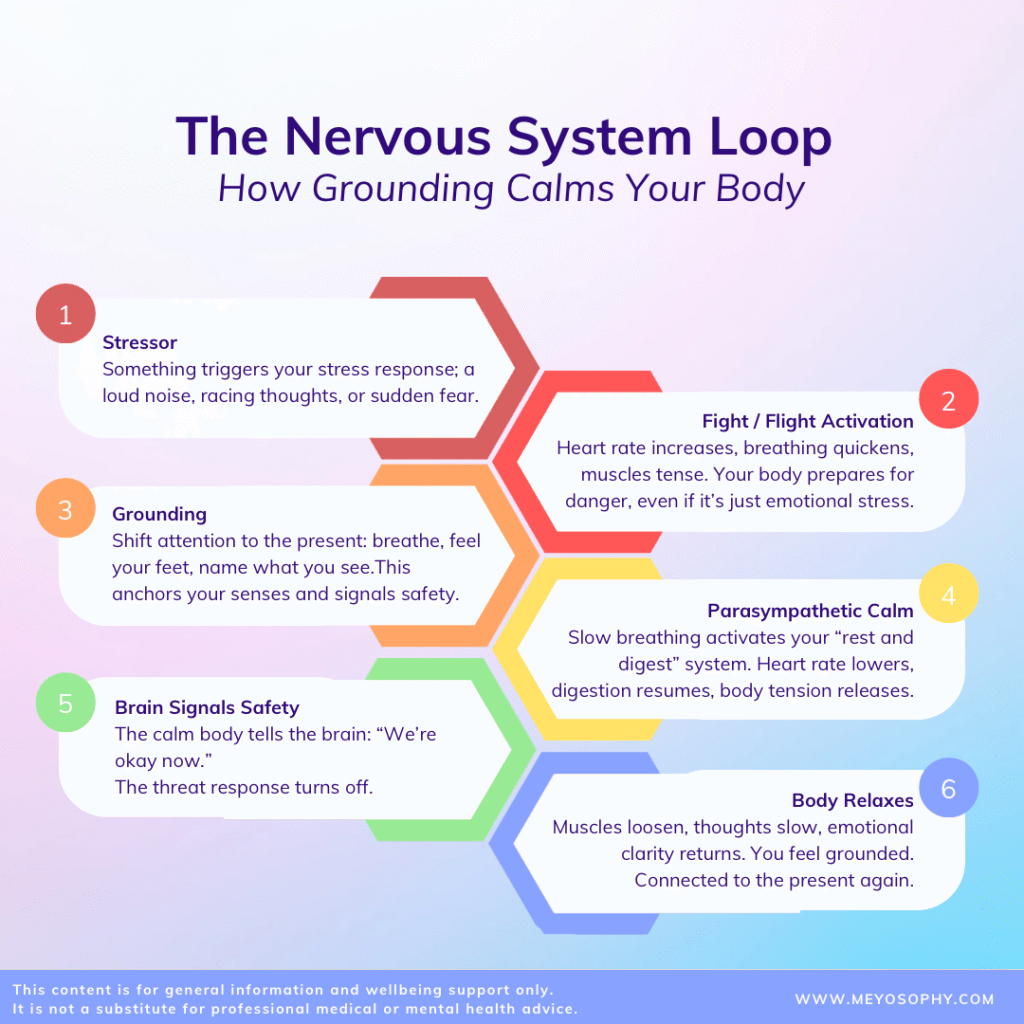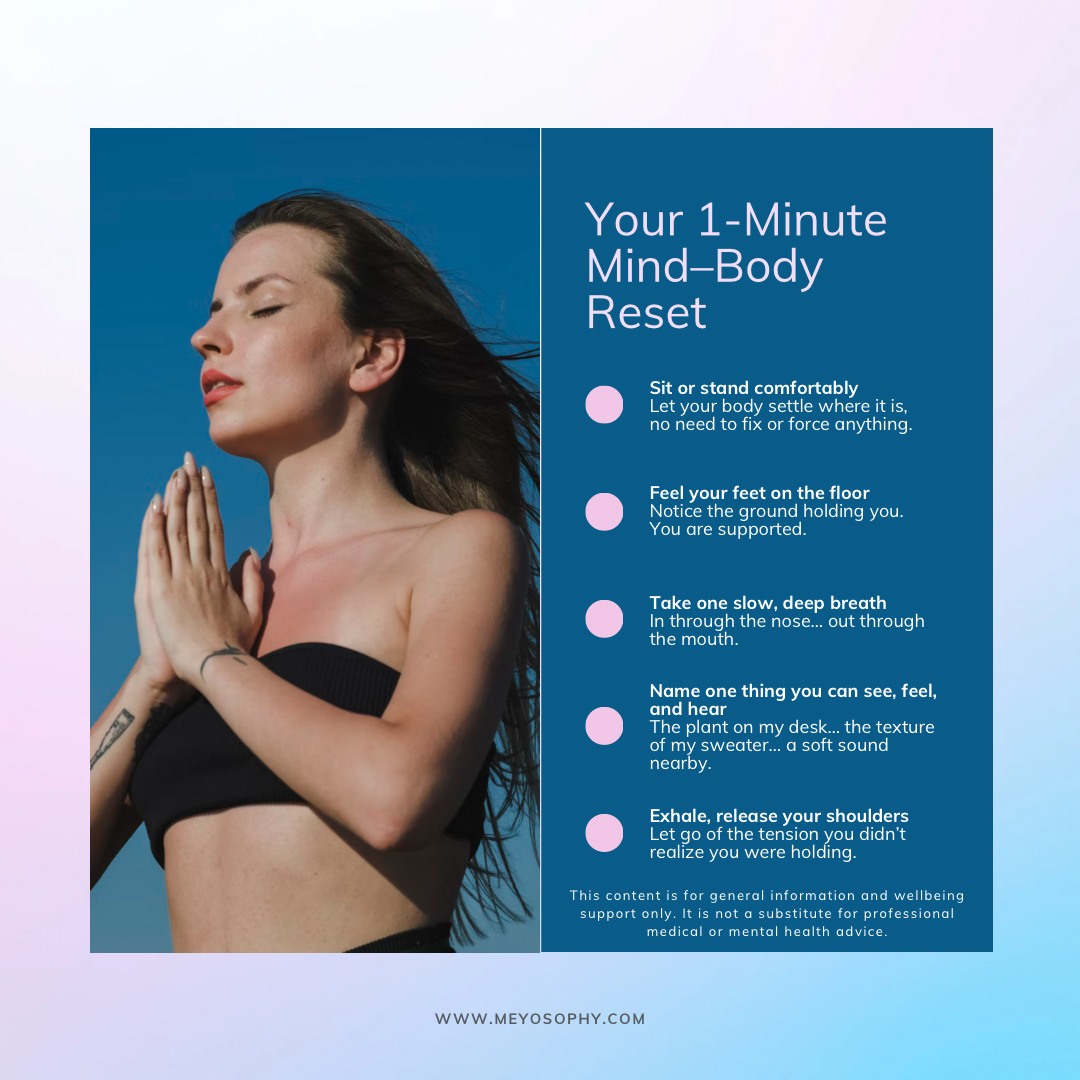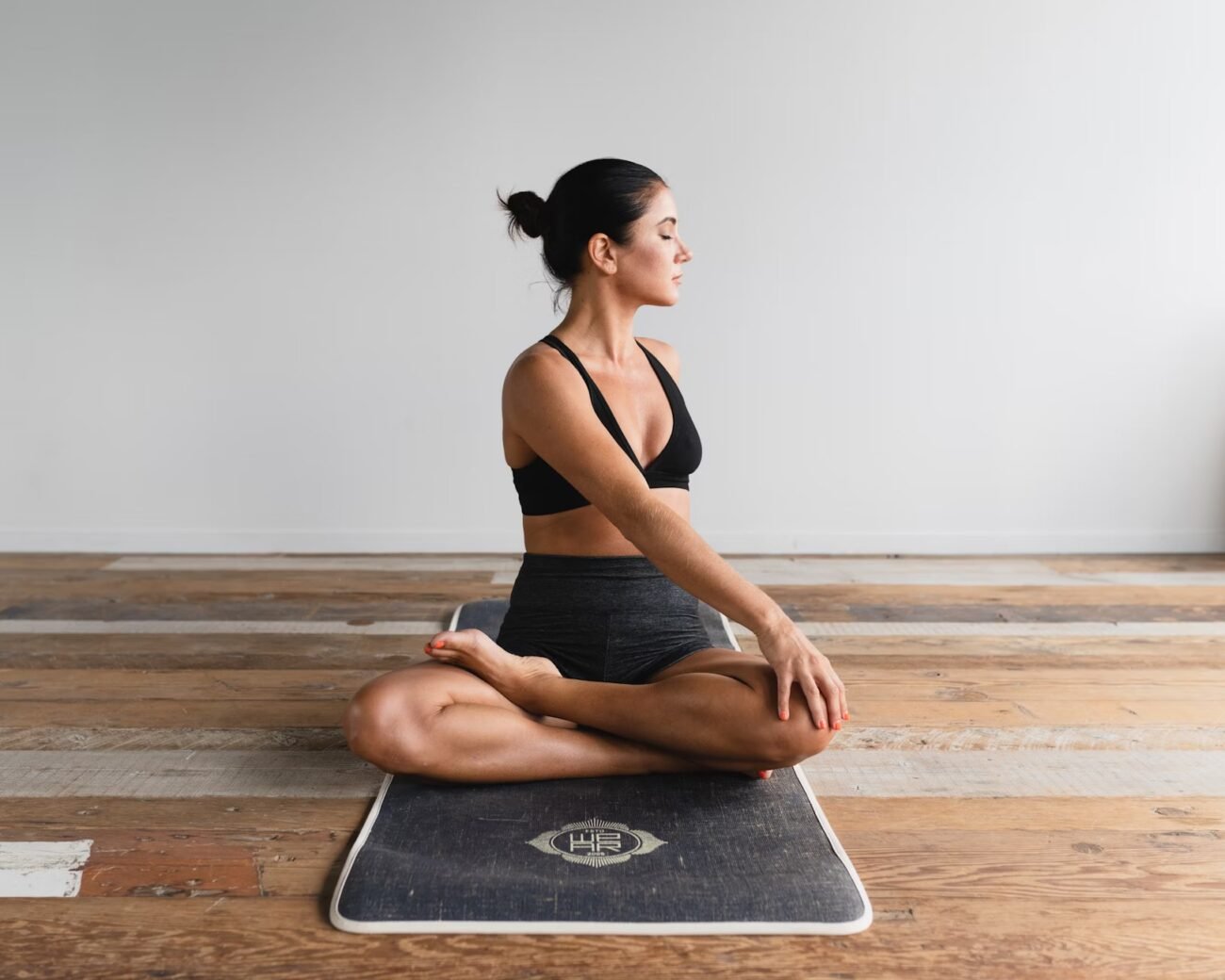When you live with anxiety, depression, derealization, or many other mental health issues, it can feel like your mind and body exist in separate worlds. You might feel detached from reality, stuck in your head, or so exhausted that you barely notice your body at all. But one of the most healing things you can do is to start gently reconnecting. Not through force, but through awareness.
These mind-body connection exercises help you feel grounded again, calm your nervous system, and rebuild a sense of safety within yourself.
Disclaimer: The information in this article is for general informational and educational purposes only. It is not intended as medical, psychological, or therapeutic advice. It’s not a substitute for professional medical or mental health advice. If you’re struggling with anxiety, depression, or any other (mental) health problem, please reach out to a licensed professional or visit findahelpline.com for free, confidential support anywhere in the world. 💛
Why the Mind-Body Connection Matters
The connection between our mental and physical states is constant. Your body reacts to your thoughts and emotions, and your mind responds to your body’s signals. When you’re anxious, your heart races and breathing quickens. When you’re depressed, you might feel heavy, sluggish, or tense. These are not “just in your head” they’re full-body experiences.
When this connection becomes disrupted (for example, through chronic stress, trauma, or a panic attack) you can feel like you’ve “checked out” of your body. Some people describe this as depersonalization (feeling detached from yourself) or derealization (the world feels dreamlike or unreal). These experiences are often the brain’s way of protecting you from emotional overload or danger signals, but over time, the disconnection itself becomes distressing.
Mind-body work helps rebuild that bridge. It reminds your nervous system that it’s safe to be in your body again, that you can experience sensations without fear. Studies show that practices combining movement and mindfulness (like yoga, tai chi, or somatic grounding) can significantly reduce anxiety and depression symptoms and help regulate the body’s stress response.[1]
The Science Behind It
Your nervous system has two main branches:
- The sympathetic system (fight, flight, freeze): activates during stress or panic.
- The parasympathetic system (rest and restore): helps you calm down and recover.
When you live in constant stress or emotional strain, your body may get “stuck” in a fight-or-flight loop. Gentle movement, grounding, and sensory awareness help re-engage the parasympathetic system, signaling to your brain that you’re safe.
This is why breathing slowly, stretching, or noticing physical sensations can instantly make you feel calmer. Your body is literally shifting gears.
Read more about the nervous system and it’s relation to mental health here.

Exercises to Reconnect With Your Body
You don’t need equipment, special training, or lots of energy for these exercises. Start small. The goal is presence, not performance. If things feel to much, skip the exercise or try at a later moment.
1. Grounding With the Senses
If you experience anxiety or derealization, your mind might drift into “unreal” sensations. Grounding with your senses brings you back to the present moment.
Take a slow breath and notice:
- What you can see: name five colors or shapes in your surroundings.
- What you can feel: touch something textured, like a blanket or your clothing.
- What you can hear: listen to distant and close sounds.
- What you can smell or taste: for example a candle, coffee, or mint.
You can also hold something warm (like a mug) or cool (like a stone) and describe it in detail. This helps remind your brain: I am here, in this moment, in this body.[2]

2. Mindful Walking
Walking can be more than exercise, it can be grounding therapy.
Start by walking slowly and paying attention to the rhythm of your steps. Notice how your feet touch the floor, how your breath moves, how air feels on your skin.
If your thoughts drift, gently return to your senses. Even five minutes helps.
This is particularly powerful for depression and anxiety because it encourages gentle activation of the body while focusing awareness on something safe and getting consistent movement.[3] I personally really like color walks. It’s where you pick a color, like blue, and on your walk you’re just looking for things in that color. It makes your attention go outward and you’ll see new things every time.
3. Somatic Stretching
Somatic stretching focuses on how your body feels rather than how it looks. Lie down or sit comfortably. Gently roll your shoulders, reach your arms overhead, or twist slowly from side to side. As you move, pay attention to sensations: warmth, tightness, tingling, or release.
You can say to yourself: “I am safe in my body. I can move gently.”
Research shows that somatic awareness (noticing sensations without judgment) helps regulate the nervous system and reduces symptoms of trauma, anxiety, and DP/DR.[4]
4. Shaking or Free Movement
Animals naturally shake after stress to release adrenaline and humans can, too. Stand up, put on soft music, and gently shake your arms, hands, and legs. Let your shoulders drop, your head move freely, your breath flow naturally.
If it helps, you can transition into free movement or dancing (no choreography, no pressure). This can discharge stored tension and help your body “complete” the stress cycle.[5]
5. Gentle Yoga or Qi Gong
Mindful movement forms like yoga or qi gong combine breath, posture, and awareness, ideal for depression, anxiety, and nervous system regulation.
Try simple poses like child’s pose, legs-up-the-wall, or a slow forward fold. Even sitting cross-legged and breathing deeply counts. If you experience depersonalization, stay connected to physical sensations: the floor beneath you, air moving through your nose, the feel of your heartbeat.
Studies consistently show that yoga and similar practices improve emotional regulation and reduce both anxiety and depressive symptoms.[6]
How These Practices Help Specific Conditions
Anxiety & Panic
Grounding and movement signal safety to a body that constantly expects danger. They slow the heart rate, deepen breathing, and reduce stress hormones like cortisol. Over time, the body learns that sensations (like a racing heart or lightheadedness) are not emergencies, they’re just signals.
Depression
Depression often disconnects us from pleasure and body awareness. Mind-body work gently reawakens both. Movement increases serotonin and dopamine, while sensory awareness breaks the “autopilot” numbness. You begin to feel something again: warmth, breath, or even mild relief, and those moments matter.
Derealization & Depersonalization
When you feel detached or unreal, grounding with your body helps bring you back to the here and now. Practices that include gentle physical sensations (temperature, touch, breath) are safer than purely “in your head” techniques. Over time, these exercises teach your brain that presence is not dangerous. It’s safe to inhabit your body again.
Tips to Make It Easier
- Start small. Even one minute of slow breathing counts.
- Pair it with something you already do. Stretch while waiting for coffee to brew or focus on your breath before bed.
- Make it sensory. Smell something pleasant, wrap yourself in a soft blanket, or feel sunlight on your skin.
- Be patient. Reconnecting with your body can feel uncomfortable at first, especially if you’ve experienced trauma or panic. Take it slowly and take a break if you need one.
- Keep it kind. This is not a performance or a workout. It’s a relationship with yourself.

How Often to Practice
There’s no perfect schedule, but consistency helps.
- Daily mini check-ins: 1–5 minutes of grounding or slow breathing.
- A few times per week: short movement practices like stretching or yoga.
- Whenever symptoms arise: sensory grounding during anxiety or DP/DR moments.
Even gentle consistency teaches your nervous system: “I am safe in this body. I can stay here.”
Combining Mind-Body Work With Professional Support
Mind-body exercises are powerful, but they don’t replace therapy or medical care. Many therapists now include somatic or body-based work within cognitive-behavioral or trauma therapies.
If you find that anxiety, depression, or DP/DR symptoms persist or intensify, reaching out to a mental health professional can provide deeper tools and support. Combining therapy with these exercises often leads to the best results.
Final Thoughts
Reconnecting with your body is a gentle act of self-trust. When you’ve spent months (or years) feeling detached, anxious, or lost in thought, the idea of feeling again might seem overwhelming. But the truth is, your body wants to feel safe with you again.
You don’t have to rush or “fix” anything.
Start with one breath, one stretch, one moment of noticing your hands or heartbeat.
That’s how you begin to come home to yourself.
Sources
- Zhu, Li et al. Mind-body exercises for PTSD symptoms, depression, and anxiety in patients with PTSD: A systematic review and meta-analysis. PubMed, 2022.
- Healthline. Grounding Techniques: Exercises for Anxiety, PTSD, and More. 2024.
- Ahead App. The Mindful Way Through Depression: Healing With Movement Practices. 2023.
- Verywell Health. Somatic Stretching: What It Is and How It Works. 2024.
- AJC. 4 Somatic Exercises to Relieve Stress and Increase Mind-Body Connection. 2024.
- ToneOp. Mind-Body Connection: Benefits & Exercises. 2024.

